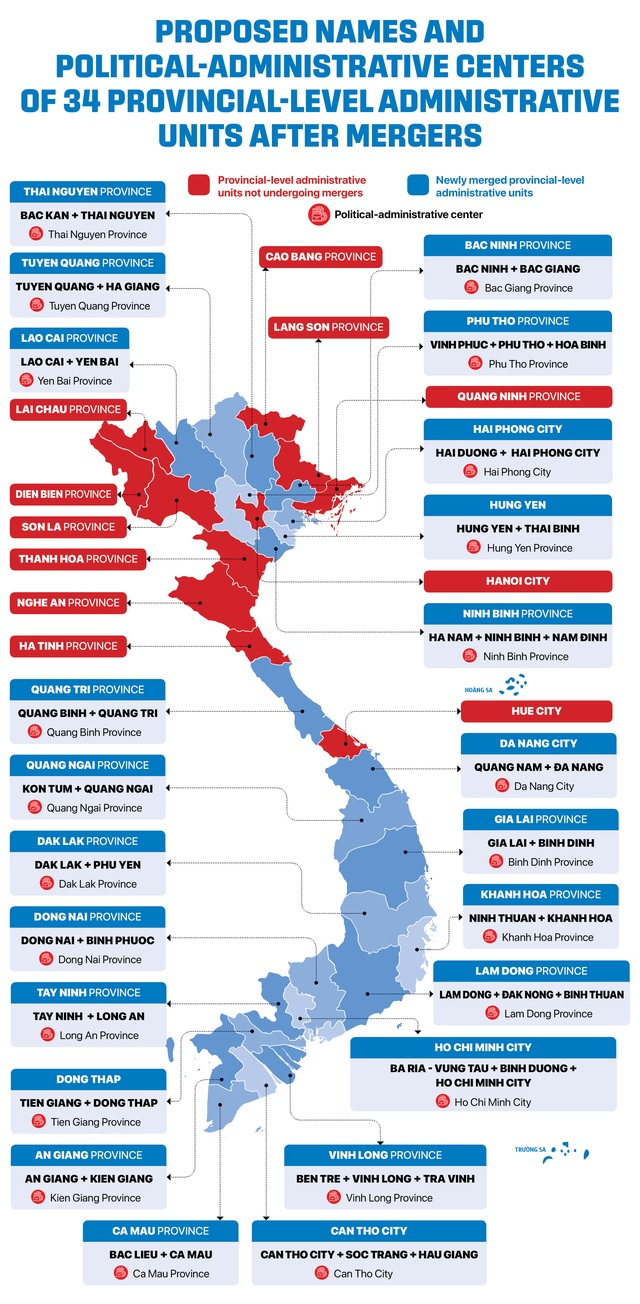Vietnam is entering a new phase of governance as the National Assembly has officially approved the merger of several provinces, with implementation set to begin on July 1, 2025. This long-anticipated move aims to modernize the country’s administrative structure, improve public service efficiency, and reduce budgetary waste. The government has now released the official list of provinces and cities to be merged, marking the most significant redrawing of Vietnam’s administrative map in decades.
Why Is Vietnam Merging Provinces and Cities?
The decision stems from years of policy planning and national discussion around the inefficiencies of managing numerous small, overlapping administrative units. Many provinces, especially in the northern and central regions, have relatively small populations and underperforming local governance structures.
Key goals of the merger initiative include:
Reducing administrative costs and redundancies
Improving public service delivery
Streamlining regional development planning
Creating stronger, more competitive localities in the context of globalization
This initiative is part of a broader vision for digital transformation, urban planning, and socio-economic restructuring.
Officially Approved Mergers Starting July 1, 2025
After extensive policy reviews, public consultations, and evaluation of provincial capacity, the National Assembly of Vietnam has officially approved the first wave of provincial mergers, to be enacted from July 1, 2025. This restructuring aims to create more efficient and economically viable administrative units, especially in regions where population sizes are small, public service systems are fragmented, and budgetary constraints hinder long-term development.

Below are the officially approved provincial mergers included in the July 2025 reform:
- Tuyen Quang – Ha Giang → Tuyen Quang Province
- Lao Cai – Yen Bai → Lao Cai Province
- Thai Nguyen – Bac Kan → Thai Nguyen Province
- Phu Tho – Vinh Phuc – Hoa Binh → Phu Tho Province
- Bac Ninh – Bac Giang → Bac Ninh Province
- Hung Yen – Thai Binh → Hung Yen Province
- Hai Phong City – Hai Duong → Hai Phong City
- Ninh Binh – Nam Dinh – Ha Nam → Ninh Binh Province
- Quang Binh – Quang Tri → Quang Tri Province
- Da Nang City – Quang Nam → Da Nang City
- Quang Ngai – Kon Tum → Quang Ngai Province
- Gia Lai – Binh Dinh → Gia Lai Province
- Khanh Hoa – Ninh Thuan → Khanh Hoa Province
- Lam Dong – Binh Thuan – Dak Nong → Lam Dong Province
- Dak Lak – Phu Yen → Dak Lak Province
- Ho Chi Minh City – Binh Duong – Vung Tau → Ho Chi Minh City
- Dong Nai – Binh Phuoc → Dong Nai
- Tay Ninh – Long An → Tay Ninh Province
- Can Tho City – Soc Trang – Hau Giang → Can Tho City
- Vinh Long – Ben Tre – Tra Vinh → Vinh Long Province
- Dong Thap – Tien Giang → Dong Thap Province
- Ca Mau – Bac Lieu → Ca Mau Province
- An Giang – Kien Giang → An Giang Province
The mergers are designed based on several criteria, including geographical adjacency, shared economic zones, cultural compatibility, and infrastructure connectivity. Importantly, these mergers are not merely administrative changes, but strategic moves to align with Vietnam’s broader national goals: enhancing digital governance, reducing redundancy in the public sector, and supporting inclusive regional growth.
Benefits Expected from the Mergers
Vietnam’s provincial merger initiative is more than a technical administrative adjustment, it represents a strategic restructuring of public governance, designed to deliver long-term economic, institutional, and societal gains. From optimizing resource use to attracting large-scale investment, the benefits are expected to ripple across multiple levels of government and daily life. Below are the key benefits the government anticipates from the newly merged provinces:
Cost Savings and Fiscal Efficiency
One of the primary motivations for merging provinces is to reduce the financial burden of maintaining an excessive number of small-scale administrative units. Estimates from the Ministry of Home Affairs suggest potential annual savings of thousands of billions of VND nationally once all phases of the merger are in place.
Reduced payroll expenses: Provinces that previously required two full sets of leadership teams – People’s Committees, People’s Councils, Party structures, and civil service staff—can now consolidate positions, leading to significant personnel cost reductions.
Lower infrastructure maintenance costs: Government offices, vehicles, facilities, and equipment that were previously duplicated across neighboring provinces can now be repurposed or decommissioned.
Streamlined procurement and operations: Unified budgeting, supply procurement, and IT systems will reduce redundancy and bring better cost control.
Improved Public Service Delivery
Smaller, less resourceful provinces have often struggled to provide equal-quality services in healthcare, education, justice, and social welfare. Through mergers, provinces gain:
Better access to specialized expertise: Centralizing services means provinces can afford more qualified professionals, such as specialist doctors, skilled educators, and IT experts.
Faster administrative processes: With simplified boundaries, procedures like land registration, business licensing, and birth certification can be streamlined through shared databases and offices.
More uniform service standards: Previously, residents of poorer provinces might have experienced different public service quality. Merged provinces will adopt unified service benchmarks and citizen charters.
Stronger capacity for disaster response and social welfare: Especially in regions prone to floods or landslides (e.g., northern mountains or central coast), a larger administrative body allows for more coordinated emergency planning and quicker deployment of resources.
Stronger Investment Appeal and Economic Clout
Larger administrative units with better infrastructure and unified policies are more attractive to both foreign and domestic investors. Moreover, merged provinces may have greater lobbying power when applying for central budget support, ODA (Official Development Assistance), and strategic projects like smart city development or green energy zones. Investors typically seek:
Administrative predictability: A unified province can offer consistent investment procedures and zoning regulations, eliminating inter-provincial conflicts or overlaps.
Larger consumer bases and labor pools: Bigger provinces mean access to larger markets and more human resources.
Improved infrastructure coordination: Projects such as expressways, industrial parks, and logistics hubs can be planned at scale without delays from inter-jurisdictional negotiations.
Unified Regional Planning and Development Strategy
Fragmented regional development often leads to duplicated efforts, misaligned priorities, and inefficient use of land and resources. Mergers allow for the creation of coherent master plans that span transportation, urban development, agriculture, and environmental management.
Integrated transportation networks: Provinces that previously managed roads, bridges, ports, and rail independently can now collaborate seamlessly. This reduces project overlap and enables long-term transport visioning.
Harmonized land use planning: Land designated for agriculture, industry, or urban expansion can now be organized logically across broader areas, avoiding overdevelopment or land disputes.
Environmental protection: Watershed management, forest conservation, and waste treatment can now be coordinated across natural boundaries rather than artificial provincial lines.
Energy and resource efficiency: Power grid extension, solar/wind farms, and public utilities can be optimized across regions.
Institutional Reform and Digital Government Acceleration
Provincial mergers also act as a catalyst for digital transformation and governance modernization. As duplicated IT systems are merged and legacy systems phased out, citizen services will become more accessible, mobile-first, and responsive.
Unified citizen databases and ID systems
Cross-provincial digital service portals for health, education, tax, and public feedback
Consolidated e-Government platforms with AI-supported decision-making tools
Cloud-based storage and analytics, replacing outdated paper-driven processes
Conclusion
Vietnam’s move to merge provinces marks a historic administrative reform, aiming to create more effective, responsive, and financially sustainable local governments. As the country faces new challenges in globalization, urbanization, and digitalization, this step positions Vietnam toward a leaner, smarter public sector. Beginning July 1, 2025, millions of citizens will live under newly merged jurisdictions – a transformation that could reshape not only the administrative map but also the governance philosophy of modern Vietnam.


